Dragon Antique Walking Canes
Gentleman's Fashion Statement...
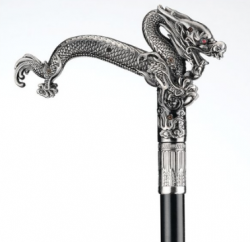
In both the East as well as West, dragons are a symbol of power. A wizard who can handle a dragon or a knight who is able to slain this gigantic creature will demand the power of his universe. It is frequently the satanic power, other times a guardian's. For this reason it is a extremely favored motif for men's walking sticks. With an antique dragon walking stick, you'll be able to carry that power in your hand, and it is quite suitable as a gentleman's fashion item.
While various dragon tales are found across Western World, quite a few of the most famed ones are coming from the British Isles, and a number of cane-makers built beautiful walking cane handles named after these dragons. Here are some of the most famous "named" dragons that are currently available as canes:
While various dragon tales are found across Western World, quite a few of the most famed ones are coming from the British Isles, and a number of cane-makers built beautiful walking cane handles named after these dragons. Here are some of the most famous "named" dragons that are currently available as canes:
St. George's Dragon

One of the most well-known dragons is St. George's. It is found in numerous artistic representations, including the walking sticks. There are a number of different variations of St. George's dragon stories, but the most popular one is of the dragon attacking the city of Selene in Libya. This dragon demanded a child every day for its food, and one day the king's daughter was chosen for the sacrifice. Just as the dragon was about to devour her up, a European knight arrived to rescue her. Upon a long brutal battle, the knight ultimately killed the dragon, and freed the city. Everyone was so thankful that they switched to Christianity under St. George.
In the old English tale of St. George, the dragon called Dadianus is an malefic sorcerer who can shift himself into a snake. St. George captured the wicked spirit of Dadianus in the walking cane he carries for eternity to observe the victory of good over evil.
There are many different artistic representations of St. George's dragon, but the dragon wrapping all around the cane is most favored.
In the old English tale of St. George, the dragon called Dadianus is an malefic sorcerer who can shift himself into a snake. St. George captured the wicked spirit of Dadianus in the walking cane he carries for eternity to observe the victory of good over evil.
There are many different artistic representations of St. George's dragon, but the dragon wrapping all around the cane is most favored.
Lambton Dragon
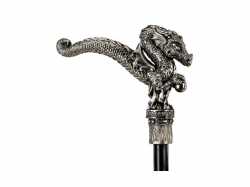
Another well known dragon in England is Lambton dragon from the tale of the Lambton Worm and Penshaw Hill. This was during the time of the Crusades that John Lambton caught a repulsive, dark-colored, worm-like creature while fishing. He did not want to take it home, so he threw it to an ancient well and forgot about it. The years passed, and he was gone on the Crusades for a very long time. When he came back home, he found out his village ruined by the worm, which had now evolved into a monsterous dragon. With the help of a sagacious woman, he was able to destroy the dragon, but his family was cursed and for nine generations no lord of Lambton would die peacefully
Even though a currently purchasable reproduction cane with Lambton dragon seems like an Asian dragon, various older drawings indicate that Lambton dragon is more like a sea serpent monster without legs or scales.
Even though a currently purchasable reproduction cane with Lambton dragon seems like an Asian dragon, various older drawings indicate that Lambton dragon is more like a sea serpent monster without legs or scales.
Henham Dragon

The Henham dragon was first sighted in 1668 in the British village of Henham, Essex. It was reported as being nine feet long with small wings. The eyes were surrounded by unusual feathers. A number of sightings of the dragon were documented over the next year. Many merely caught a glimpse of it in the distance, while some others stated it flew overhead. In 1669, a pamphlet called “The Flying Serpent or Strange News Out of Essex” was printed and a print of the pamphlet still exists at Saffron Walden library. This dragon was actually a hoax known as the "Henham Dragon Hoax of 1668." Still, it stimulated the imaginations of numerous artists and craftsmen, who fashioned some very lovely walking sticks.
Brinsop Dragon
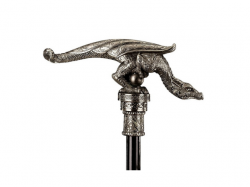
This dragon resided in a well in Duck’s Pool Meadow in Brinsop. It was slaughtered by a local knight, but some people believe that this knight was in fact St. George. Yes, he was a quite busy man! The majority of pictures identified for this dragon display huge wings which is typical for currently available pictures. The dragon sculpture on the existing reproduction stick is actually very nice looking, although most likely difficult to take around.
Asian Dragon
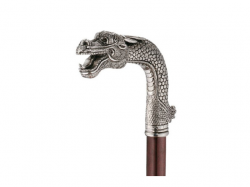
While they are not British, it is worth mentioning Asian dragons. Unlike in the European counterpart, in Asian legends dragons are typically in pairs, one good and one evil. If a good dragon wins, the village will thrive. If the evil one wins, the village will perish. They are a kind of symbol of the yin-yang relationship. One of most popular dragon stories from China is of a black and a white dragon. A famous wood carpenter was traveling with his son to a distant country. They walked by one side of an threatening lake, with an island in the middle covered by a dark cloud. The son was thirsty and sipped water from the lake when, abruptly, a black dragon sprang out from the cloud, seized the son, and vanished. The father ran to the nearby village for aid but no one could possibly do anything at all. Half-crazed, he began chiselling a dragon from white wood laying around the side of the lake. He carved and carved without food, without rest. When he removed the last chip from the dragon's eye, instantly the wooden dragon came alive, flew to the black cloud, and began battling with the black dragon. After long strugling, both dragons disappeared under the lake, the black cloud cleared from the island, and the carpenter saw his boy sitting on the island.
The Asian dragons have no wings, but always have four legs, a pair of lengthy whiskers and normally a beard. It is very simple to identify one from the European dragons.
The Asian dragons have no wings, but always have four legs, a pair of lengthy whiskers and normally a beard. It is very simple to identify one from the European dragons.
Dragon Craws
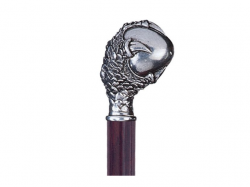
A dragon-claw cane is a more new creation from fantasy books and films. A dragon claw holding a crystal or silver sphere is extremely common. According to stories, the hand of a dragon was a talisman for many wizards. The sphere held in the dragon’s claw represents the world, and he who possess this talisman will master the world. You can buy a number of reproductions in this type. These walking canes are pretty popular among ladies involved in goth and/or vampire fashion than men and may not be as suitable as a gentleman's fashion cane.
Though quite a few classic dragon walking sticks from the 19th century or earlier were made of wood, bone, and ivory, the presently readily available dragon walking sticks are generally made of pewter, and often built in Italy. Some no-name less costly dragon walking sticks are made in China and India. (Don't discount Indian craftsmanship, however. They make really nice canes at a reasonable price.) None of these walking canes are for orthopedic use. They are meant only as a gentleman's fashion accessory, and inexpensive ones are for home decorations.
